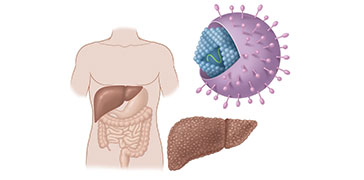US Pharm. 2021;46(10):15-16.
Viral Infection That Attacks the Liver

Hepatitis C is caused by a virus that infects the liver. Unlike most viruses, it is spread only through contact with infected blood. Most people infected with the hepatitis C virus (HCV) do not have symptoms for many years, so they are unaware of their condition. Several drugs for treating hepatitis C are very effective, and new treatments cause fewer side effects than older drug regimens. Hepatitis C affects more than 3 million people in the United States and causes thousands of deaths each year from liver-related diseases. This infection increases a person’s risk of developing cirrhosis and liver cancer.
Symptoms May Not Develop for Many Years
An acute hepatitis C infection occurs within the first 6 months after exposure to the virus. Symptoms, which can sometimes appear weeks or months after infection, may include nausea, vomiting, loss of appetite, diarrhea, fever, headache, and abdominal pain.
Up to 25% of people with an acute infection clear the virus from their blood without treatment. In most people, however, the virus remains in the bloodstream, and the infection becomes chronic. A chronic hepatitis C infection causes liver damage and inflammation. Healthy liver tissue dies and is replaced by scar tissue. If left untreated, hepatitis C infection can lead to permanent liver failure, making liver transplantation necessary.
Not Spread by Casual Contact
HCV is not spread by casual contact with others, such as shaking hands or hugging. Direct exposure to an infected person’s blood or bodily fluids is how HCV is transferred. The most common route of infection is through sharing of contaminated needles or syringes used to inject drugs. Unprotected sex with someone with hepatitis C is also a common route of infection. Babies born to infected mothers can contract hepatitis C.
People with a high risk of hepatitis C infection should be tested routinely. Those at increased risk include current or past IV drug users, individuals with HIV, those who have had blood transfusions before 1992, hemophiliacs treated with blood factors before 1987, and those who have undergone long-term hemodialysis treatment. Blood testing is done initially, and a liver biopsy may be recommended if a blood test is positive.
Even without other risk factors, people born between 1945 and 1965 should receive a one-time blood test, since 75% of all persons with chronic hepatitis C were born during this time. Many people in this age group are unaware that they are infected. Test results allow doctors to plan treatment to clear the virus and avoid liver damage.
Treatment and Monitoring
It is recommended that treatment with antiviral medications begin immediately after diagnosis without waiting for spontaneous clearance of the virus.
There are seven different genotypes of HCV, and the genotype determines which drug treatment will be successful. Other factors considered when choosing the appropriate medication regimen include the presence of cirrhosis, prior HCV infection, or coinfection with HIV and hepatitis B. Direct-acting antivirals are oral medications used, often in combinations of two or three drugs, to manage HCV infection. The simplified treatment for most HCV infections lasts for 8 to 12 weeks. Antiviral medication works by preventing the virus from multiplying. Successful treatment means no detectable virus in the blood 12 weeks after completing drug therapy; this is known as a sustained virologic response. Today’s medications are highly effective, resulting in a 95% cure rate. Side effects are generally mild and include headache, nausea, fatigue, and sleep disturbances.
Blood tests are performed regularly to monitor treatment progress and detect potential liver cancer. People with chronic hepatitis C infection should eat a healthful diet, avoid alcohol, and take their medicine as prescribed. No vaccine is available for preventing hepatitis C infection. The best prevention is to avoid behaviors that increase the risk of infection.
The content contained in this article is for informational purposes only. The content is not intended to be a substitute for professional advice. Reliance on any information provided in this article is solely at your own risk.
To comment on this article, contact rdavidson@uspharmacist.com.





